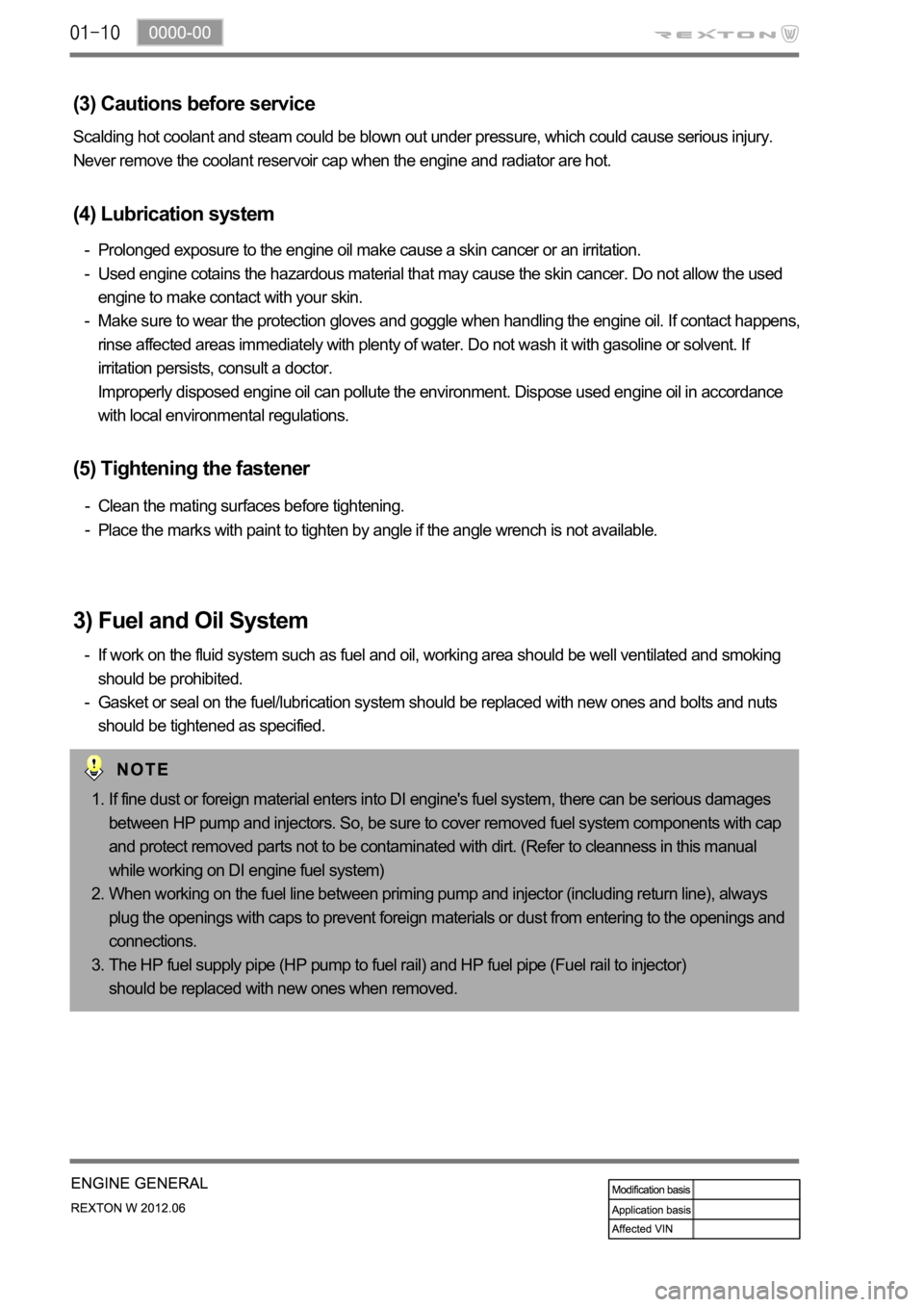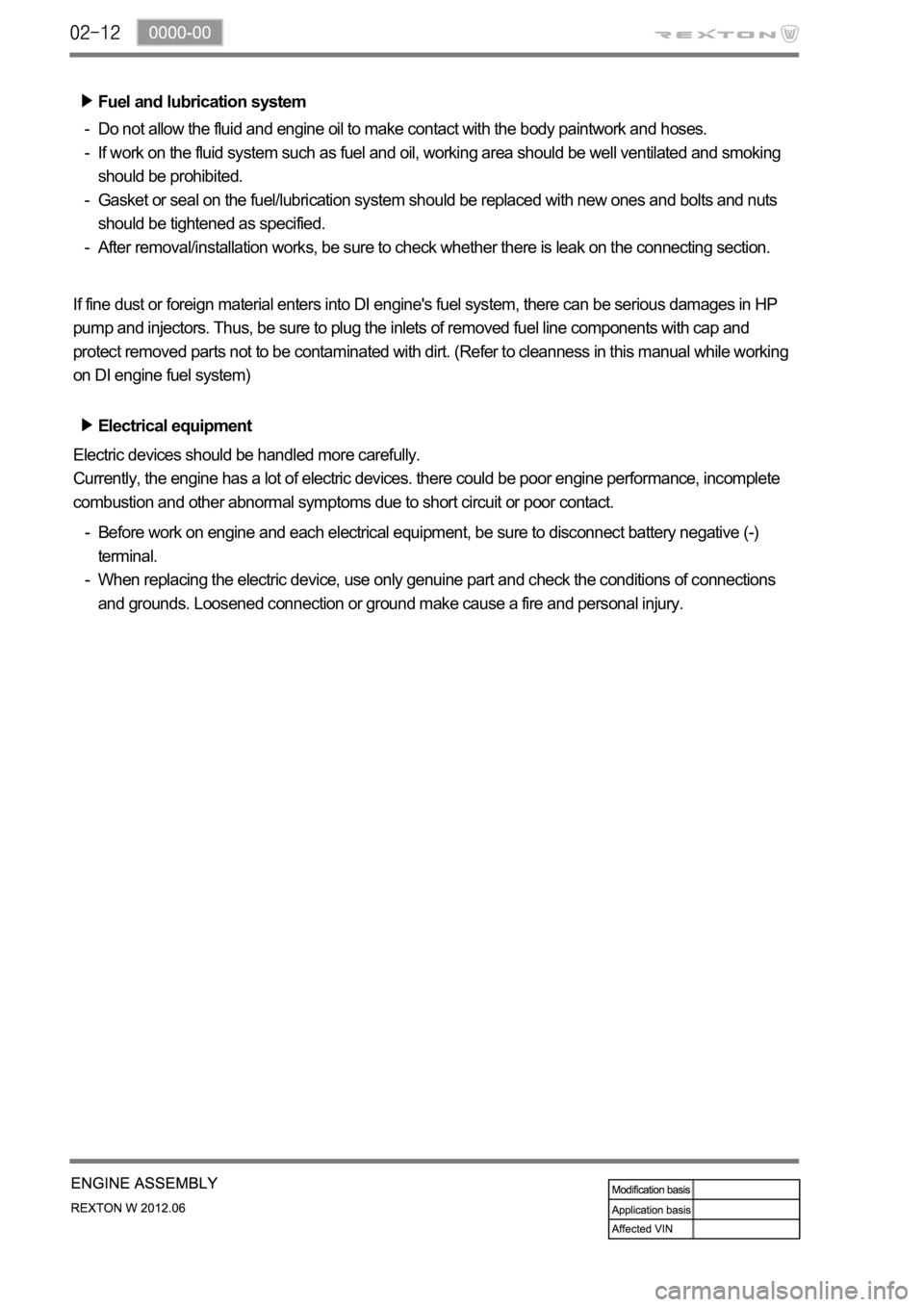Page 263 of 600

0000-00
4. CAUTION WHEN SERVICING THE ENGINE
1) Cleaness
Engine has a lot of precisely machined (grinding, polishing, lapping) surfaces. Thus, there should be great
cautions for cleaness when servicing the engine components. Apply the engine oil on the sliding surfaces
when assemblying the components. Every component should be disassembled and reassembled in
accordance with the correct sequences. Before servicing the engine, the negative cable should be
diconnected from the battery. Otherwise, some electric or electronic components could be damaged.
2) Servicing
(1) Lifting up the vehicle
Always keep the safety precautions.
To prevent the vehicle from rolling down, put the chocks under the tires (when using a 4-post lift).
Make sure to support the correct lifting points (when using a 2-post lift) -
-
-
(2) Exhaust system
Wear the safety glove when removing the exhaust pipe.
Make sure that the exhaust pipe is cooled before removing it. -
-Before service work, be sure to disconnect battery negative (-) terminal to prevent damages by bad
wire and short.
To prevent the foreign material from getting into engine cylinder, cover the inlet of air cleaner if the
air cleaner has been removed -
-
Page 264 of 600

(3) Cautions before service
Prolonged exposure to the engine oil make cause a skin cancer or an irritation.
Used engine cotains the hazardous material that may cause the skin cancer. Do not allow the used
engine to make contact with your skin.
Make sure to wear the protection gloves and goggle when handling the engine oil. If contact happens,
rinse affected areas immediately with plenty of water. Do not wash it with gasoline or solvent. If
irritation persists, consult a doctor.
Improperly disposed engine oil can pollute the environment. Dispose used engine oil in accordance
with local environmental regulations. -
-
-
(5) Tightening the fastener
If fine dust or foreign material enters into DI engine's fuel system, there can be serious damages
between HP pump and injectors. So, be sure to cover removed fuel system components with cap
and protect removed parts not to be contaminated with dirt. (Refer to cleanness in this manual
while working on DI engine fuel system)
When working on the fuel line between priming pump and injector (including return line), always
plug the openings with caps to prevent foreign materials or dust from entering to the openings and
connections.
The HP fuel supply pipe (HP pump to fuel rail) and HP fuel pipe (Fuel rail to injector)
should be replaced with new ones when removed. 1.
2.
3. Scalding hot coolant and steam could be blown out under pressure, which could cause serious injury.
Never remove the coolant reservoir cap when the engine and radiator are hot.
(4) Lubrication system
3) Fuel and Oil System
If work on the fluid system such as fuel and oil, working area should be well ventilated and smoking
should be prohibited.
Gasket or seal on the fuel/lubrication system should be replaced with new ones and bolts and nuts
should be tightened as specified. -
-Clean the mating surfaces before tightening.
Place the marks with paint to tighten by angle if the angle wrench is not available. -
-
Page 275 of 600
(2) Cylinder pressure leakage test
If the measured value of the compression pressure test is not within the specifications, perform the
cylinder pressure leakage test.Specified value
Perform this test in the sequence of firing order.
Do not test the cylinder pressure leakage with wet type test procedure. (do not inject the engine oil
into the combustion chamber) -
-
Test condition: normal engine operating Specified value
Whole engine below 25%
at valve and cylinder head gasket below 10%
at piston ring below 20%
Crank the engine for approx. 10 seconds by
using the start motor. 2.
Record the test result and measure the
compression pressure of other cylinders with
same manner. 3.
If the measured value is out of specified
value, perform the cylinder pressure leakage
test. 4.
Page 278 of 600

0000-00
4. GUIDELINES ON ENGINE SERVICE
To prevent personal injuries and vehicle damages that can be caused by mistakes during engine and
unit inspection/repair and to secure optimum engine performance and safety after service works, basic
cautions and service work guidelines that can be easily forgotten during engine service works are
described in.
Cautions before service works
For safe and correct works, you must observe the working procedures and instructions in this
manual. And, use the designated tools as follow:
Engine stand / Heavy duty engine jack
To prevent the engine from starting abruptly, do not allow anybody to get in the vehicle while
servicing in engine compartment.
Before work on engine and each electrical equipment, be sure to disconnect battery negative (-)
terminal.
Before service works, be sure to prepare the works by cleaning and aligning work areas.
Do not allow the foreign material get into the fuel injection system.
When removing the engine, use only the safety hook on engine and engine hanger. Do not support
the bottom of oil pan with a jack.
Engine and accessories
-
-
-
-
-
-
Completely drain the engine oil, coolant and fuel from engine before removal.
Before disassembling/assembling the engine components, carefully read the working procedures in
this manual.
Make sure to keep the specified tightening torques during installation.
Clean and properly lubricate the parts before reassembly.
Carefully check that there are not any interference while servicing. -
-
-
-
-
Page 279 of 600

Electrical equipment
Electric devices should be handled more carefully.
Currently, the engine has a lot of electric devices. there could be poor engine performance, incomplete
combustion and other abnormal symptoms due to short circuit or poor contact.
Before work on engine and each electrical equipment, be sure to disconnect battery negative (-)
terminal.
When replacing the electric device, use only genuine part and check the conditions of connections
and grounds. Loosened connection or ground make cause a fire and personal injury. -
-Fuel and lubrication system
Do not allow the fluid and engine oil to make contact with the body paintwork and hoses.
If work on the fluid system such as fuel and oil, working area should be well ventilated and smoking
should be prohibited.
Gasket or seal on the fuel/lubrication system should be replaced with new ones and bolts and nuts
should be tightened as specified.
After removal/installation works, be sure to check whether there is leak on the connecting section. -
-
-
-
If fine dust or foreign material enters into DI engine's fuel system, there can be serious damages in HP
pump and injectors. Thus, be sure to plug the inlets of removed fuel line components with cap and
protect removed parts not to be contaminated with dirt. (Refer to cleanness in this manual while working
on DI engine fuel system)
Page 285 of 600
Brake booster and naster
cylinderVacuum pump
Pump capacity: 210 cc/rev
Camshaft speed: 375 to 3,000 rpm
Lubrication temperature: -40 to
Oil: 5W30
Drive type: Driven by exhaust
Camshaft sprocket
2. VACUUM PUMP
Vacuum pump generates the vacuum pressure and supplies it to EGR cooler bypass solenoid. This
pump is single vane type and displacement is 210 cc/rev. The lubrication oil is supplied through the hole
in hollow shaft.
Components
EGR cooler bypass valve
This valve is controlled by ECU.
When the engine is cooled, the
exhaust gas goes to combustion
chamber without passing through
EGR cooler because the valve is
closed by vacuum pressure.
Page 291 of 600
2) Oil Separator
Oil separator separates the particle in blow-by gas to minimize the engine oil consumption and reduces
the inflow oil from intake system into the combustion chamber. The separated oil returns to oil pan
through cylinder head.
Oil separator
Blow-by outlet hose
(1) Overview
(2) Layout
Page 294 of 600
0000-00
Intake/Exhaust Camshafts
2) Camshaft
(1) Overview
Hollow type camshaft contains cam, octagon cam, HP pump gear and intake/exhaust gears.
Camshaft operates the intake/exhaust valves, vacuum pump and HP pump, and transfers the engine
oil to vacuum pump through the internal oil passage.
(2) Location
Exhaust CamshaftExhaust Camshaft
Octagon cam
(for tooling)
Thrust journal
Connected to
vacuum pump
Intake Camshaft
Closed flow type water jacket (improving cooling performance)